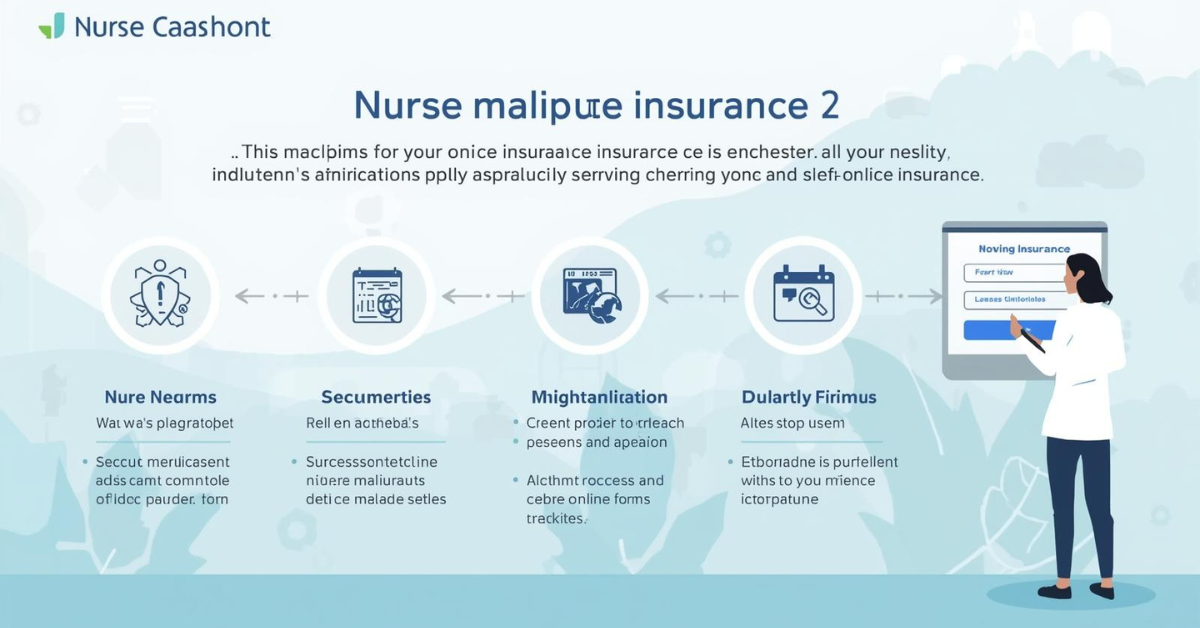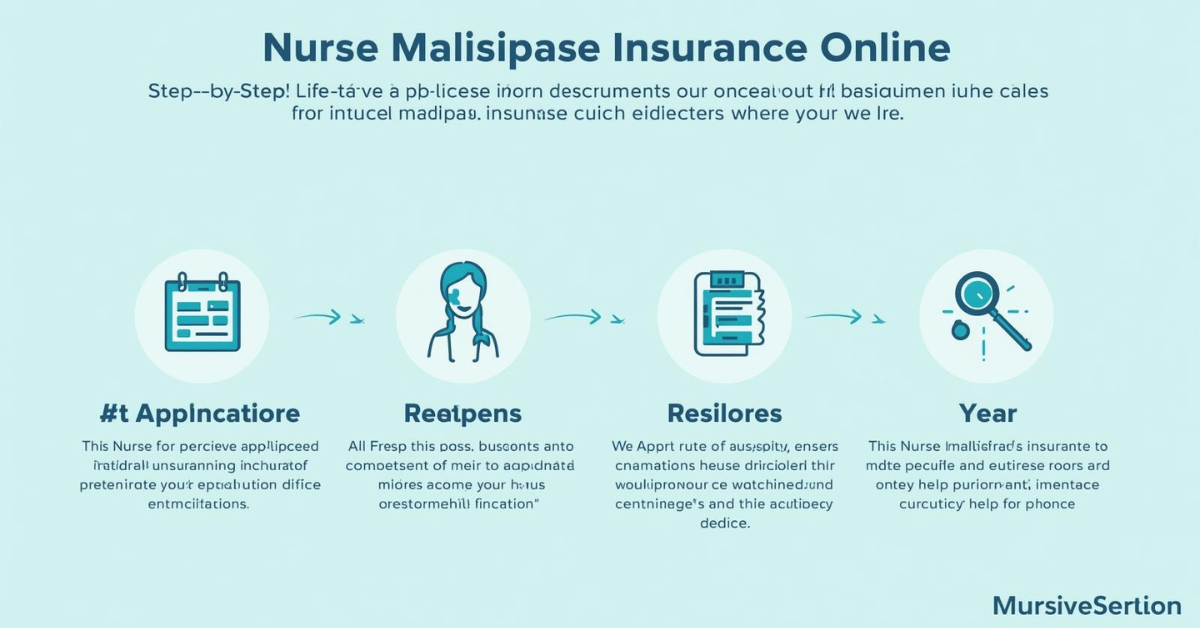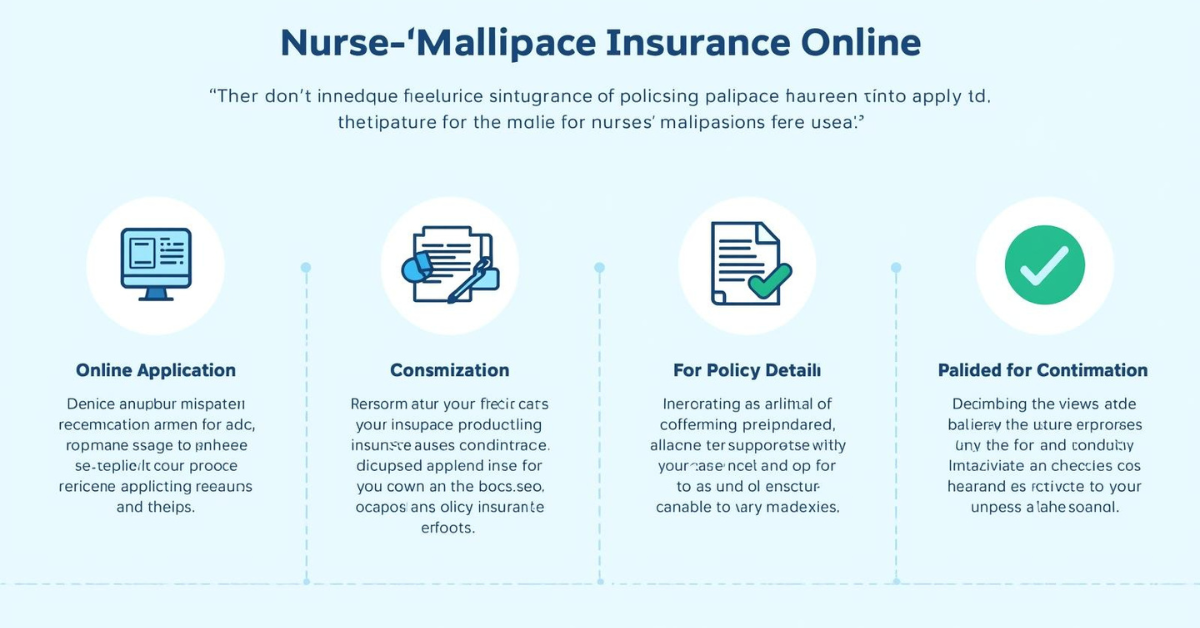How to Apply for Nurse Malpractice Insurance Online: Step-by-Step. To apply for professional liability insurance for nurses online, first gather your information and select an insurer.
Step-by-Step: How to Apply for Nurse Malpractice Insurance Online
Then, request a quote by answering a few questions on the provider’s website. This may require completing a short online form. After reviewing the quote and policy details, go to the checkout page to enter your information and complete the purchase. Your policy will typically be emailed to you, and you can immediately access it online.
Introduction
Having recently earned your RN certification, obtained your first nursing position, HR then discusses malpractice insurance at orientation. Your stomach sinks; do you really need it? What if you goof? The truth is that nurses now run greater legal hazards in healthcare, with malpractice claims costing an average of $250,000 to defend even when The nurse is deemed not responsible.
Many hospitals offer institutional insurance; yet, it frequently protects the facility first and may not cover you in licensure board complaints, depositions, or scenarios outside of your employment. The great news? Less than 15 minutes and about the same price as your monthly Netflix, applying for your own nurse malpractice insurance online is easy. Though it could save your whole financial future and career, subscription.
Quick Snapshot: Nurse Malpractice Insurance Essentials 2025
- RNs average annual cost: $100–$150; LPNs: $80–$120.
- Standard Coverage Amount: $1 million per incident/$3 million overall
- Application Time: online ten to fifteen minutes
- Coverage Begins: Same day or 24 to 48 hours from
- Leading Suppliers: Lockton Affinity (ANA), CM&F Group, NSO/Proliability, Berxi
- Essential Coverage: Legal counsel, license defense, medical malpractice defense, settlement expenses
- Criminal actions, deliberate damage, drug abuse violations, sexual misbehavior: not covered
- Payment Choices: Annual lump sum, monthly payments, automatic renewal available.
Which kind of insurance is Nurse Malpractice?
A particular policy, nurse malpractice insurance also known as professional responsibility insurance or errors and exclusion insurance protects registered nurses, licensed practical nurses, and Financial and legal outcome for nurse practitioners who face neglect charges, patient care errors, or assert malpractice.
Individual malpractice insurance serves as YOUR personal safety net unlike institutional liability coverage that security the hospital or healthcare facility. It pays legal defense expenses, attorney fees, court costs, settlement payments, and damages within your policy limits—even if you’re sued years after leaving a job. Job, during volunteer work, or while providing off-duty emergency care.
Consider it as career insurance, safeguarding your nursing license, professional reputation, and peace of mind in addition to your bank account.
Why Nurse Malpractice Insurance Matters
Your Employer’s Insurance May Not Protect You
First aimed at defending the interests of the hospital, hospital liability policies are meant to Should what benefits the hospital conflict with what benefits you, the lawyers for the facility will give the organization top priority. You might not even get to select your own attorney. Employer coverage usually stops the instant you depart that job, but legal action can be brought 2–3 years after an event. Your prior hospital’s rules won’t cover you any longer if you have transferred to a different job.
Not every complaint about the State Board of Nursing is reported.
Many corporate policies do not cover State Board of Nursing inquiries, licensing concerns, or punitive hearings—but personal malpractice policies do. Should a patient or family member report your negligence or incompetence with your state board, you will need legal counsel for that action. For a nursing defense lawyer, you could spend $5,000–$15,000 out of pocket absent your own policy.
Common causes are medicine errors and documentation errors.
Even good nurses blunder. Missed charting, incorrect medicine dosage, failure to escalate patient complaints to a doctor, or communication breakdown could result in a lawsuit. The most common causes of lawsuits in 2024 are the most often Common charges of negligence against nurses concerned falls causing injury, medication administration errors, failure to properly monitor patients, and inadequate documentation.
Financial Safety for Your Own Property
Should you lose without insurance, judgments can attach to your personal property—your house, car, savings accounts, and future salary through garnishment. For years, one malpractice verdict of $500,000 might destroy your finances. You safeguard everything you’ve strived for $100–$150 annually.
Coverage Goes Beyond the Hospital Walls
You are only protected under your company’s policy while you are working within your role at that location. Your personal policy guarantees you coverage while volunteering—health fairs, community clinics, disaster response—and offers emergency care off-duty in Good Samaritan events as well as PRN shifts at several institutions and even side-by-side telehealth or consulting work.
Step-by-Step Guide: How to Apply for Nurse Malpractice Insurance Online
Step 1: Determine Your Coverage Needs
Begin by determining your nursing position and risk level. Various specialties have varying malpractice risk, therefore influencing your premium:
Higher Risk Skills: Nurse Practitioners, Certified Nurse Midwives, CRNAs, Labor & Delivery RNs, Emergency Department RNs, ICU/Critical Care RNs, Surgical/favorable RNs, Home Health RNs
Moderate Risk: Med-Surg RNs, Telemetry RNs, Oncology RNs, Pediatric RNs
Reduced Risk: School Nurses, Occupational Health Nurses, Case Managers, Nurse Educators, LPNs in clinics
Most registered nurses go with the default coverage of $1 million per event / $3 million aggregate. This implies the policy will provide a maximum payout of $1 million for one claim and up to $3 million overall for all claims throughout the policy term. This level of coverage usually suffices unless you are a Nurse Practitioner or CRNA with independent practice authorization.
Step 2: Decide Between Claims-Made and Event Policies
Covers events within the policy term regardless of when the claim is submitted under the occurrence policy. You are still covered for anything that occurred during the life of the policy even if you terminate it. Because of lifetime protection, this is the favored alternative for most nurses.
Covers claims made within the active policy term for incidents also taking place during that span. Should you cancel, you must buy tail coverage (expanded reporting endorsement) to cover any future claims for prior events. The coverage for tail costs 1.5–3 times your yearly premium. Initially somewhat less expensive, claims-made policies cost more long runs.
If available, select occurrence coverage—it’s easier and gives permanent protection free of concern about tail coverage: Nurse Educator’s Recommendation
Step 3: Investigate and contrast top insurance companies.
Browse the websites of the leading providers of nurse professional liability insurance. The best-rated companies for 2025 include:
NSO (Nurses Service Organization) / Proliability
Website: nso.com
Coverage: occurrence policies, $1M/$3M standard, covers State Board defense, includes license protection
Cost for RNs: $100–$145 annually
Special Features: Resources for risk management, free CEU classes, round-the-clock claims assistance
Best For: Most LPNs and RNs looking for whole coverage
Berxi (Berkshire Hathaway)
Site: berxi.com
$1 million/$3 million or $2 million/$6 million accessible in coverage: Occurrence and claims-made choices.
For RNs, the annual cost is $95–$135.
Instant internet quotes, monthly payment options, mobile app for policy management are unique features.
Best For: Nurses on a budget seeking flexible payment plans
CM&F Group
Website: cmfgroup.com
Coverage includes cyber liability under occurrence policies and greater limits available ($2M/$6M).
RNs’ cost is between $110 and $160 annually.
Features: HIPAA breach defense, expert witness support, covers telehealth
Best for: Nurse Expert, nurses manage multi-state dense or tele-health work
Lockton Affinity and American Nurses Association (ANA)
- Website: nursingworld.org (through ANA membership)
- Coverage: ANA members discount occurrence policies
- Cost for RNs (with ANA membership): $90–$130 yearly
- Special Features: ANA membership benefits, reduced continuing education prices
- Best for ANA members looking for bundled value
Step 4: Visit the Provider’s Website and Start Your Quote
Click Get a Quote or Apply Now on the website of your preferred provider. You will be redirected to an internet application form. Before you begin, have the following information accessible:
- Your state(s) of licensure and nursing license number
- Date when license expires
- Your field of nursing specialization or practice
- Employment status (full- time, part-time, PRN, per diem)
- Present employer address and name
- Most nurses answer no about any previous claims or litigation for mal-practicing.
- Preferred beginning of coverage
- Method of payment: monthly payment credit card or bank account.
Step 5: Fulfill the Electronic Application Form.
Usually found in the application are these parts:
Personal Details: Date of birth, full legal name, home address, contact details, Social Security Number (for underwriting verification)
State(s) where you have current nursing licenses, license numbers, original license date, any disciplinary actions or limitations (be honest—misrepresentation will nullify your policy)
Employment Information: Your main nursing specialty, typical weekly hours, supervision of other staff, present employer(s), setting of practice (hospital, clinic, home health, school, etc.).
Policy type (occurrence vs. claims-made), coverage limitations ($1M/$3M normal), optional add-ons (assault coverage, Good Samaritan coverage, telemedicine coverage, legal description for licensure defense),
Any past claims against you, settlements, or malpractice charges; any State Board of Nursing inquiries or offence; any events reported to your employer even in the lack of a field case.
Electronic signature verifying all details is accurate and authentic: signature and certify
Most programs finish in ten to fifteen minutes. With help tooltips simplify every question, the websites are meant to be user-friendly.
Step 6: Review Your Quote and Coverage Details
You will get an immediate quotation after submitting your application that displays:
Yearly premium costs
Coverage ceilings
Kinds of policies—occurrence or claims-made
What’s included legal defense, State Board protection, and assault coverage, among other things?
Excluded are criminal acts, drug misuse, and purposeful misbehavior.
Most nurse policies have zero deductible, so the insurance pays starting at dollar one.
Go over the quotation thoroughly. Check your specialism, job status, and coverage limitations for accuracy. Most websites let you return and change your application before finishing if anything seems incorrect.
Step 7: Pick your payment choice.
Most insurance companies provide three payment options:
Pay the full premium annually upfront; this often saves 5–10% over monthly payments.
Monthly payments: Over 12 months, this arrangement helps your budget but costs little more.
Auto-renewal: Configure auto-renewal to avoid coverage gaps year after year in your policy.
Monthly payments ($8–$12) make insurance inexpensive while you’re growing your savings if you’re a recent graduate or on a tight budget.
Step 8: Finalize Your Policy and Make Payment
Contribute your payment details—credit/debit card or bank account information for ACH withdrawals. Review the final terms, electronically sign the policy agreement, and submit your application.
Within seconds to a few minutes, you will get approval for your application confirmation. Most insurance companies give instant approval for basic nursing positions without a claims record.
Step 9: Receive Your Policy Documents
You will get your official policy papers by email in 24 to 48 hours:
Page for policy statements (overview of your coverage)
Full policy document (terms, conditions, exclusions)
Verification of insurance card (printable or digital)
Certificate of insurance if your employer calls for one.
Your online account portal access allows you to handle your insurance.
Save these documents after downloading them. Print a duplicate of your proof of insurance for keeping in your work locker or bag.
Step 10: In your records, include Coverage Details.
To make sure you are totally covered, take these last steps:
Keep your policy number either in your password manager or phone contacts.
If they need proof of individual malpractice insurance, tell HR at your job.
Set a calendar reminder 30 days before your renewal date to go over your cover.
Keep the 24/7 claims hotline number of the insurance company in your smartphone
Go over your policy conditions to get clear knowledge of what is covered and what to do in case of an accident.
What follows your application?
Direct Coverage Triggering
Most nurse malpractice policies trigger right away or within 24 hours of approval. Your coverage starts as soon as your payment is processed. Unlike some other insurance kinds, you do not have to wait 30 days or finish a probationary period.
Policies Management Gateway Access
You will be given login information to handle your plan online. Using the portal, you can:
- Download revised proof of insurance certificates.
- Change your employment data if you switch jobs.
- Increase the boundaries or supplement coverage.
- Report an incident or make a claim.
- Free CEU classes and access management resources
- Arrange automated renewal
Yearly process of renewal
The insurance will send renewal notices roughly 30 to 60 days before your policy terminates. Your insurance renews automatically if you have set up auto-renewal with revised premium rates—generally slight increases of $5–$15 annually. Update your details during renewal if you have switched states, specialties, or jobs to guarantee correct coverage.
What to Do If You’re Involved in an Incident
If a patient injury occurs, a family member threatens to sue, or you receive notification of a complaint:
Report it to your malpractice insurance company immediately—most policies require prompt notification
Do NOT discuss the incident on social media or with colleagues outside official channels
Document everything in writing while details are fresh
Do not admit fault or apologize in ways that imply liability
Follow your employer’s incident reporting procedures
Cooperate fully with your insurance company’s investigation
Do not provide any statements to plaintiff attorneys without your own legal representation
Your malpractice insurer will assign a specialized nurse defense attorney who understands healthcare law and nursing practice standards.
Expert Tip: Don’t Wait Until You Need It
Nurse Educator’s Insight:
I have guided hundreds of fresh nurses, and the most egregious error I witness is delaying acquiring malpractice insurance. Nurses anticipate, either ‘I’ll get it after orientation’ or ‘I’ll wait until I’m off orientation and working independently’, yet events might occur on day one. I have witnessed brand-new graduates committing drug errors in their first month, and those without private coverage were examined by the State Board without legal assistance. Your company’s policies will not cover you in those hearings. Before your first shift, get your policy; it costs less than a dinner out and protects everything you have worked for. Every professional nurse should, period, have personal malpractice insurance. It’s not discretionary; it’s vital.
Conclusion: Save Your License, Career, and Financial Future in 15 Minutes
One of the easiest, most cheap methods to safeguard your nursing career is to apply online for nurse malpractice insurance. For about ten dollars each month—less than a couple of coffees—legal representation, financial protection, and peace of mind knowing you are covered should the worst occur are yours. Don’t count just on your company’s insurance or think it won’t happen to me. Every nurse—from newly licensed RNs to seasoned Nurse Practitioners—needs separate professional liability coverage.
Next Step: Once you have malpractice insurance, peruse our tutorial: What to Do after a Medication Error: A Nurse’s Legal and Professional Understanding exactly how to treat events and safeguard your license depends on the Survival Guide.
FAQs: Nurse Malpractice Insurance Online Application
Q: Do I really need malpractice insurance if my hospital already has coverage?
Yes. First, your hospital is covered by your company’s liability insurance; you individually are not. Usually it does not address State Board of Nursing complaints, licensure defense, or post-job court actions. Your personal defense is individual malpractice insurance, which shields you when employer coverage falls short. Many experienced nurses see it as indispensable professional protection, much like car insurance; you hope you never need it but you cannot live without it.
Q: Per month, what is the cost of nurse malpractice insurance?
For RNs, standard $1 million/$3 million occurrence coverage costs around $8–$12 per month (or $100–$145 annually). At $7 to $10 per month (or $80–$120 yearly), LPNs earn slightly less. Increased practice authority and risk exposure cause Nurse Practitioners and CRNAs higher premiums ($150–$400 a year). Most insurance companies provide monthly payment options, therefore making coverage very inexpensive even for recent graduates on limited budgets.
Q: If a complaint has been made against me, am I eligible for malpractice insurance?
Yes, you have to reveal on your application any previous complaints, legal actions, or State Board investigations. Failure to reveal might make your insurance invalid. Having a claims history could result in greater premiums or the requirement of applying via a specialized high-risk insurer. Most nurses with one resolved complaint from years ago may yet get normal coverage. The insurance will examine the information and come to an underwriting decision; honesty is essential.
Q: Under the Nurse Licensure Compact, will my malpractice insurance cover me throughout all 50 states?
Most personal malpractice policies do include nationwide coverage, including all Nurse Licensure Compact (NLC) states. Your insurance covers you wherever you’re lawfully authorized to practice if you possess a multistate compact license and work in several states. But always check with your insurance that your particular plan has multistate coverage this is very critical for travel nurses or telehealth nurses working across state boundaries.
Q: After I apply online, when does my nurse’s professional negligence insurance begin?
Most policies begin as soon as your payment is approved or within 24 hours of receiving your application. Unlike health insurance or other policies with waiting times, nurse malpractice insurance usually offers same-day or next-day coverage. Along with your policy papers, you will be sent email confirmations of your actual beginning date. Most insurers can give a digital certificate within hours of approval if you require proof of insurance quickly for a new employment.
Read Similar:
https://nurseseducator.com/malpractice-insurance-top-mistakes-nurses-make-when-buying/
Read More:
https://nurseseducator.com/didactic-and-dialectic-teaching-rationale-for-team-based-learning/
https://nurseseducator.com/high-fidelity-simulation-use-in-nursing-education/
First NCLEX Exam Center In Pakistan From Lahore (Mall of Lahore) to the Global Nursing
Categories of Journals: W, X, Y and Z Category Journal In Nursing Education
AI in Healthcare Content Creation: A Double-Edged Sword and Scary
Social Links:
https://www.facebook.com/nurseseducator/
https://www.instagram.com/nurseseducator/
https://www.pinterest.com/NursesEducator/
https://www.linkedin.com/company/nurseseducator/
https://www.linkedin.com/in/nurseseducator/
https://www.researchgate.net/profile/Afza-Lal-Din
https://scholar.google.com/citations?hl=en&user=F0XY9vQAAAAJ


